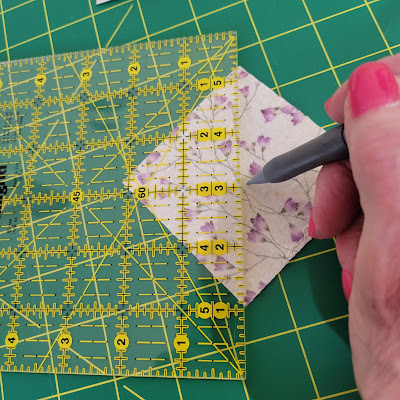I am staying busy lately making different blocks for a 30-Block Exchange Group. There are 30 members in the group and everyone makes 30 blocks and sends out 29 of them to the rest of the group. It has been just about the most fun I have had in a long time. I am currently a little over half way through. I have already received six from six of the members. I could have been through but I have been trying to write up a tutorial for each block I am making. I was doing really well at first. I didn't start a new block until after I had written the tutorial. Then after Block #6 and #7, the same block just made differently, I was writing the tutorial on my new laptop and was almost finished with the post (it was long and detailed and had taken about three or four hours to write) and I hit a key and it all disappeared. I was so upset. Unfortunately I didn't know about the backward arrow then. Trust me I do now. So that won't ever happen again. BUT I was so upset, all I wanted to do was make another block and then another block. You get the picture. I still haven't rewritten the post for the two blocks.
Today as I was making a block that was nothing but half-square triangles (HST), I thought, "Patricia, you should write up a tutorial on just making HSTs and QST" ( quarter-square-triangles). So that's what I'm doing.
Blocks with "stars" or triangles instead of squares and rectangles use HST or even QSTs. A friend Linda thinks of them all as HST just smaller and you could. I remember how I used to avoid any pattern with triangles. My problem was I just didn't know how easy they were to make.
You see I started out as a seamstress. My grandmother taught me to sew - make a simple straight skirt when I was in the 6th grade. I had to take home-ec in high school which wasn't a great experience because my teacher didn't like how I sewed and wanted me to sew her way. I made the one dress and didn't pick it back up until college when I wanted more clothes. Later in life when I started quilting, I just learned on my own.
I'm going to show you two different ways to make HST. I use both ways; it just depends on how many I need to make for the pattern and what the other half is.
The first thing you have to decide is how big the HST is supposed to be. Quilters use two different figures when they talk about pattern blocks - finished size and unfinished size. The finished size is the size when the block is finished and the unfinished size is the cut size. The difference is 1/2 inch. That's because quilters sew the seams 1/4". So 1/4" on all four sides makes 1/2" on opposite sides.
The reason I started with this knowledge is when you are making HST you want to think the finished size and it has to be made bigger than the cut or unfinished size. (I learned this the hard way the first time I had to make a triangle. I cut the squares in half to make a triangle and they were too small when I sewed them in the quilt.) You might read to make the square 7/8" bigger. I say 1" bigger. It's easier to remember and who wants to do the math anyway? I taught math and I know 3 + 7/8 = is easy but 3-1/2 + 7/8 = ? The other reason I like to make the square an inch bigger is so I can trim off the excess and truly have my HST 3-1/2. You see no matter how hard you try to make sure you are cutting the square the right amount, sew exactly 1/4" for the seam, and press it correctly, rarely will your finished product by what it was supposed to be; in my example, 3-1/2.
So we are going to cut the square 1" bigger than the finished size.
The next thing you will do is to mark the diagonal of the square.
Once you get across you can stop and cut the thread OR
Once you finish all of them, you will stop, cut the thread and
opened out and pressed on the wrong side and then
the right side, you have a HST.
Sometimes you may have a pattern that has HSTs but while one half uses the same print, the other one uses a different print as in this example. I used a charm pack which is made from 5" squares precut. The only problem was that each square in this pattern is 3", but a charm pack is the easiest thing to use for this and I had a partial charm pack I needed to use up.
trimmed off the access. I have now a triangle with two sides equally 4".
I cut the charm squares in half and
added the other half to my scrap group.































No comments:
Post a Comment